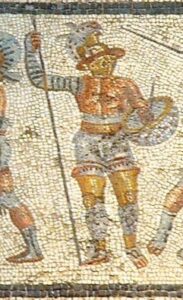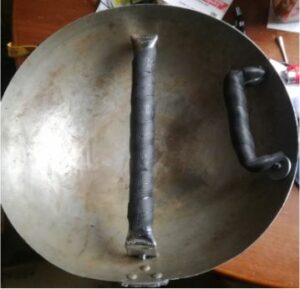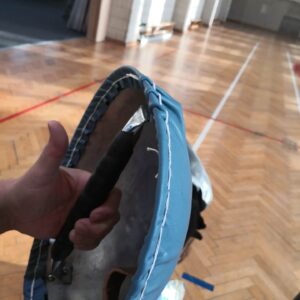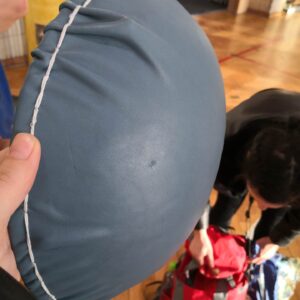„Handicraft project wok sign“
In the last week we turned the slogan „swords to ploughshares“ around and built a shield from a kitchen utensil. In the beginning there was a certain amount of research. We knew that the Hoplomachus often started with smaller, curved shields. Now we had to think about how these worked, how they were attached to the arm or whether they were held, and whether the size of the wok I had at home was actually sufficient.the best source for this are the depictions of Hoplomachus on mosaics, reliefs, clay lamps and so on. Unfortunately, the depictions are often not that detailed and others are that detailed but you can’t look into the curvature of the shields. It’s a nasty thing that the artists of that time didn’t worry about the fact that at some point re-enactors would have to rebuild the equipment.
fig1 Hoplomachus and Priapus, probably the figurehead of a tavern, Pompeii, early 1st century
fig2 Hoplomachus, detail of the „Zliten-Mosaic“, Villa Dar Buk Ammera, Zliten, Lybia, 2nd century
fig 3 Bronze statuette of Hoplomachus, 2nd century, Neues Museum Berlin
One or the other picture suggested a continuous central handle, so one was screwed into the wok. Some positions of the figures did not fit to the middle handle, so a second handle was added, which was then replaced by a leather wrist strap. Now the shield gets a leather border and the new protection for the Hoplomachus is ready. Now it is time to learn how to use it. Some bruises indicate that this point might be important.
fig 4 grip mounting
fig 5 result from inside
fig 6 result from outside
fig 7 result from opponent view
Yours Gladiatores Berolinenses (Lucilla)






